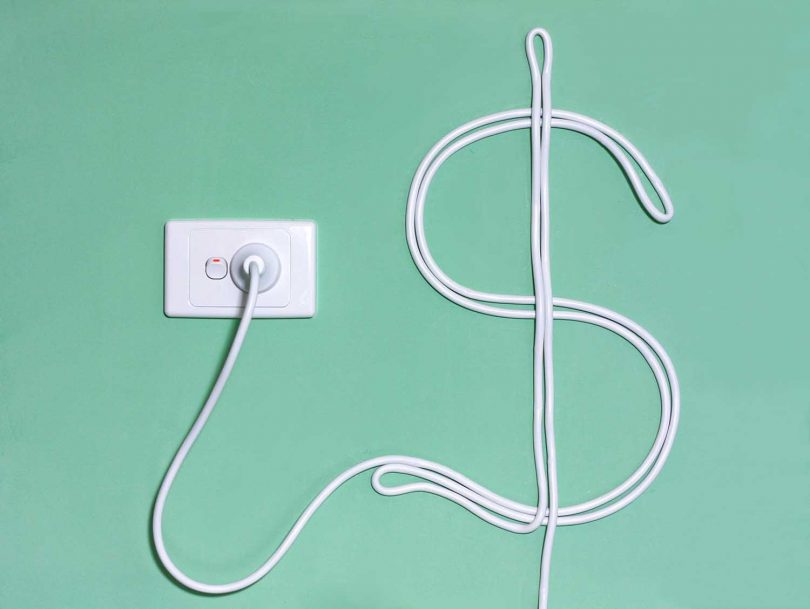The average American household spends $2,060 per year on utility bills, reports EnerygyStar.gov. These numbers have only risen since COVID-19, as people were quarantined in their homes, forcing them to use more electricity. Even now, some families continue to work or learn from home—which will only spike their energy bill. With that in mind, we’ve created this guide to help you save energy—along with some cash—fast.
Method 1: Conserve energy
The best way to save money on your utility bill is to simply use less energy. This means turning on fewer lights (and always remembering to turn them off), using your hairdryer less, watching less TV, etc. When you first start implementing this rule, leave reminders for yourself above light switches and TV’s so you’ll remember to turn them off.
Method 2: Check your water
Your water heater could be a big contributor to your high energy bill. It takes a lot of work to heat gallons upon gallons of water, so check yourself before you take a long shower or let the faucet run for a while. To avoid using a bunch of excess energy, turn down your water heater to 120 degrees Fahrenheit. This will be hot enough for a relaxing shower and won’t break the bank if you stay in for a few extra minutes.
Method 3: Get smart with your thermostat
Changing how you regulate the temperature in your home can change the cost of your energy. Keep your thermostat set to higher temperatures in the summer and lower temperatures in the winter to reduce your electricity costs. If it gets too cold, put on some extra layers. Too hot? Grab a fan.
For those willing to pay a little more upfront, think about actually getting smart with your thermostat by purchasing a smart system like Nest. This thermostat can help you save money on your energy bill by keeping energy reports and monitoring your temperature preferences. Over the course of a week, the program will create a schedule—based on what times you turned the temperature up or down—and then automatically follow said schedule. The thermostat will also suggest user-specific temperatures throughout the day that can specifically help you save money.
Method 4: Replace your lightbulbs
Believe it or not, outdated light bulbs suck up a lot of electricity. Switch out your old light bulbs for LED or smart light bulbs. They last much longer than normal bulbs and don’t waste as much electricity. When shopping, look for ENERGY STAR certified bulbs. Also, consider getting dimmer switches, which make it so that you can control the amount of light—and, in turn, energy—you use.
Method 5: Check for drafts and leaks
If you hear a drip, it’s not only annoying, but it’s wasting both water and money. Look around for both air and water leaks, as both can cause hikes in your electric and other utility bills. Use a candle to check around your doors, windows, and appliances like your fridge and freezer. Turn off any fans in the room, close all doors, and light the wick. Then, move it around the edges of where there could be a draft. If the flame flickers, you’ll know there’s an air leak there.
Method 6: Upgrade household appliances
An investment in high-efficiency appliances can help you save more in the long run. This is because older items tend to use more electricity than newer ones. So, maybe it’s time to retire your old appliances in favor of a new one that can save you more money on your electric bill. With that being said, you don’t need to replace every single thing. Stick to prioritizing ones that you use the most energy on, like the fridge, water heater, washer-dryer, TV, etc. When buying a new appliance, make sure you purchase one that’s ENERGY STAR qualified. You can also check out Sears or energystar.gov’s list of efficient appliances to find these money-saving products at affordable prices.
Method 7: Change your fridge & freezer temperatures
Don’t waste energy keeping your food colder than necessary. Refrigerators don’t need to be set any lower than 40 degrees Fahrenheit, and freezers don’t need to be colder than 0 degrees Fahrenheit. Setting temperatures any lower than that won’t keep your food any fresher, but will simply waste electricity.
Method 8: Switch out your air filters
A clogged-up air filter means more energy is needed to push air through the system. Make it easy for your airways by changing out filters. A new filter isn’t difficult to install and it can make your HVAC system run much more efficiently. It’s recommended that you change your filters approximately once every three months.
If you don’t have the money to spend on a new filter every few months, make yours last longer by cleaning it regularly. Also, clean your vents and around your air conditioning unit, especially if you have pets—as pet hair can build up and cause clogs.
Method 9: Install ceiling fans
Although being strategic with your thermostat can help lower energy costs, turning it off altogether will use even less. Instead, try installing ceiling fans, which are a more efficient and eco-friendly way to keep cool. According to the US Natural Resource Defence Council, ceiling fans use only 10% of the energy that it takes to run a central air conditioner. If you’re still too hot, open your windows to get a cross breeze.
Method 10: Remember to unplug
Most people think that powering off your electronics is good enough when it comes to saving energy. Actually, devices are still using electricity as long as they are plugged in. This is called phantom energy, and it surprisingly takes up 10% of the charges on the Average American’s electric bill.
If you want to save a little extra, fully unplug electronics when you aren’t using them or when you leave the house, or get a power strip with a switch. This way, instead of unplugging everything you just turn the strip off.
Method 11: Do your laundry on cold
90% of the energy needed to run a washer goes to heating the water, according to ENERGY STAR. This means, washing clothes with cold water could cut your energy use per load by a significant amount. In addition to using less electricity, doing your laundry on the cold setting will prevent colors from bleeding. It’s a win-win for your wallet and your white shirts. Just make sure you are using a detergent that works well in cold water—some are specially designed to work best at warm or hot temperatures.
Method 12: Air-dry your clothes and dishes
Your dryer works overtime to dry your laundry, so give it a break. Not every load of laundry needs to cycle through the dryer—it sucks up a ton of energy. Try air-drying your clothes every once in a while to lower your power bill, and prevent items from shrinking. If you don’t have the space to line-dry outside, invest in a foldable drying rack for your laundry area.
Not only should you air dry your clothes, but dishes too. Instead of putting on the heat/dry cycle, open your dishwasher a small amount and air dry your dishes after washing.
Method 13: Avoid cooking with the oven
Ovens take a lot of energy to heat up, even when you’re cooking something small. Next time you’re hungry, try using the stovetop or purchasing a toaster oven to prepare your meals. These will heat up your food in half the time it takes a larger oven and will use up half the electricity.
Method 14: Plant trees
Strategically planting trees around your home can help you save on both heating and cooling costs. Trees not only provide shade but also help regulate indoor temperatures, meaning your air conditioner won’t have to work as hard in the hot summer months. You don’t even have to spend money planting them, just plant fruit trees—which can be grown from the seeds of the fruit.
Check out this guide from the Arbor Day Foundation to learn everything you need to know about planting trees to save energy.
Method 15: Talk to your utility provider
You’ll never know if you could be paying less if you don’t ask. Some companies can offer you a special deal or arrange your bill so that charges are lower during certain times of the day. Others might give discounts for using paperless billing. Make a call to your provider and be upfront about what you want—you may be surprised by what you can negotiate.
When talking about discounts, also ask for an energy audit. Utility providers will usually do this for free and the results of the audit will show you where and how you could be using less energy in your home.








